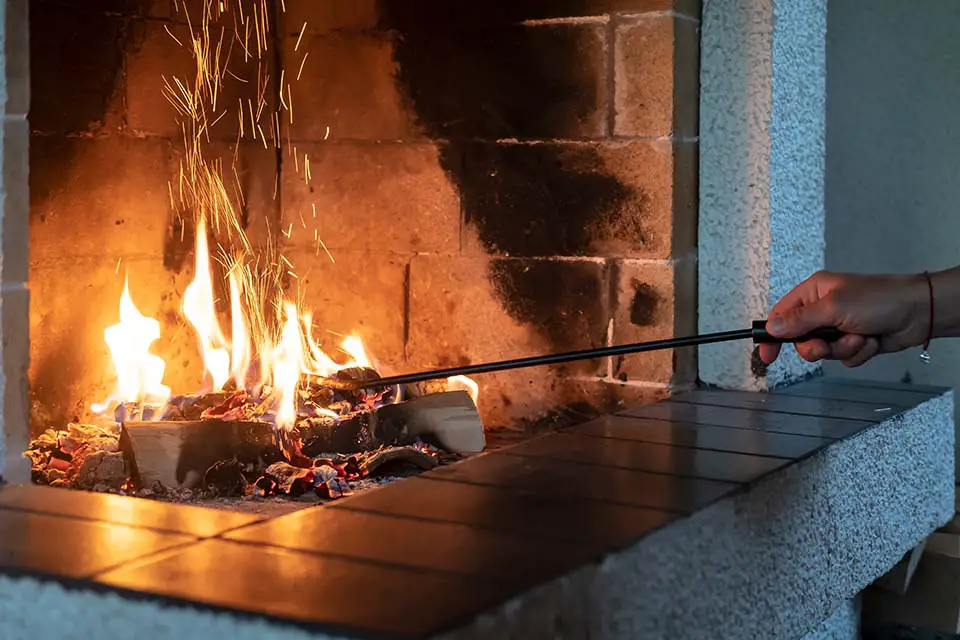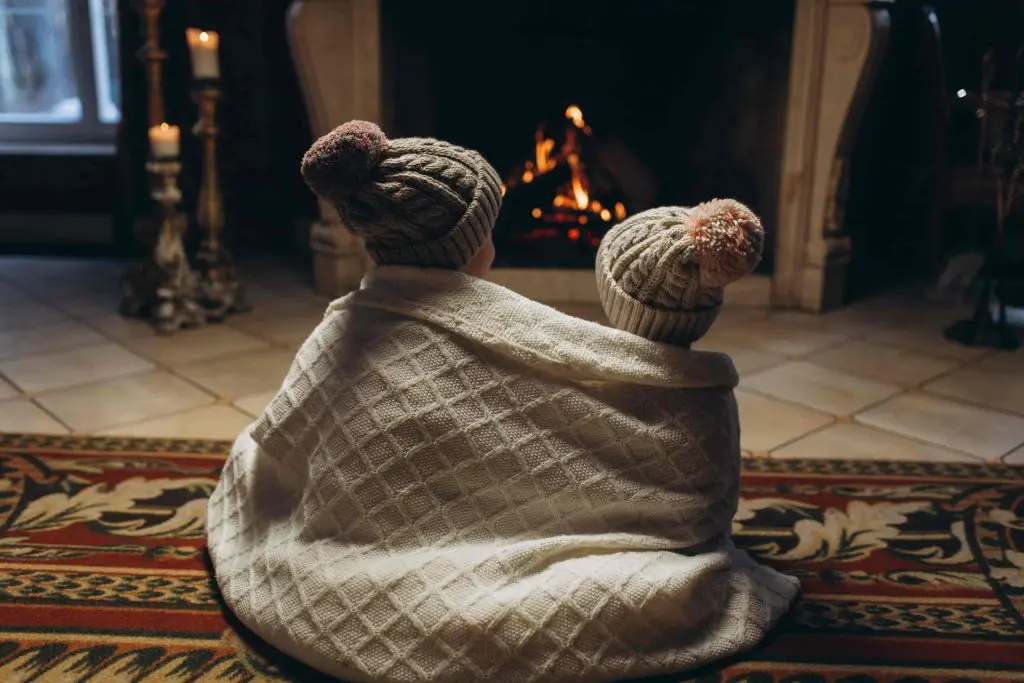- Wood fireplaces can be very economical to heat your home, but they are the most inefficient heating source, with only 10% heat efficiency.
- Wood burning stoves, on the other hand can produce 3x the heat using 1/3 as much firewood. This means they are more efficient and have more heating power than open-burning fireplaces (Source).
- In terms of aesthetics, wood fireplaces are generally more aesthetic, though there are some gorgeous freestanding wood stoves that can provide a decorative accent.
- Another wood stove advantage is that they can be left on overnight with the flame closed behind its glass door.
- Remember: there are two types of wood stoves: non-catalytic models which are EPA-approved and require almost zero maintenance. Catalytic stoves, on the other hand, are higher-end options that burn more efficiently and evenly, but you need to replace the catalyst every few years.
When you think of a wood stove, the first thing that comes to mind is a historical picture of an antique cast-iron stove in a log cabin.
If you were asked to imagine a fireplace, several more modern and rustic images would spring to mind. Most of us are more likely to think of a contemporary picture of a fireplace than a wood stove because we are more acquainted with fireplaces.
Wood stoves spread heat in all directions rather than just one making them ideal. This isn’t the same as fireplaces which generate little heat in just one place. While each has its advantages and disadvantages, research on the comparison can assist you in making an informed decision.
Contents
The Big Picture
Wood stove: Overview
A wood stove is a device that burns wood to heat a home or indoor space. The wood stoves, like fireplaces, are designed to keep fire safe. The wood stoves are separate devices made up of numerous prefabricated components designed to be used with a fireplace. They include an open chamber called the firebox where a fire may be lit and maintained; this is connected to adjacent combustion chambers by chimneys.
A chimney, a firebox, and a ventilation pipe are all parts of the wood stove. The firebox is, without doubt, the major compartment where wood is burned. It functions as a fireplace flue by releasing smoke and taking fresh air from the firebox. Smoke will leave the firebox through the ventilation pipe and chimney. At the same time, fresh air will enter the firebox through the chimney and ventilation duct.
Design and construction
A wood stove is more of a useful home heating device than an aesthetically pleasing one. A free-standing wood stove radiates heat from all sides and is a fireless cookstove. Stoves with designs ranging from modern to opulent are available to complement any décor style.
Since a stove’s major goal is practicality, some homeowners prefer one that looks like a sleek, modern furnace. While a stove may be beautiful in the right light, its greatest advantage is its ability to save you money on your energy bills by heating large sections of your house efficiently and inexpensively.
The Fireplace: Overview

A fireplace is a huge, ventilated structure that is built to contain a fire safely. They are frequently constructed of heat-resistant materials such as brick or stone and can withstand fires. To ignite the fire, you stuff the inside of the fireplace, known as the firebox, with wood. The firebox is linked to a hollow flue that rises to the chimney. Smoke leaves the firebox through the flue and chimney while fresh air enters via the chimney and flue.
For ages, fireplaces have been a part of daily life. In addition to being fashionable, they provide homeowners and family members with the pleasure of a wood fire in their homes.
Design and construction
A fireplace serves as the focal point of a space, with its mantelpiece and ornamental façade. It’s an attention-grabbing structural feature, whether it’s a prefabricated fireplace that has been integrated into the wall of a conventional masonry fireplace built into the house’s structure.
The selection of fireplace styles that you may select from is virtually boundless, with natural stone, brickwork, marble, and veneer as examples. While fireplaces have a practical value, their primary appeal is often their aesthetic attractiveness.
It’s critical to remember that an old traditional fireplace need not be replaced since the existing one can be brought up to high efficiency by adding a “fireplace insert” directly into the opening where the old wood-burning occurs.
Heat Output
![Wood Stove vs. Fireplace [Comparison]](https://ventfree.org/wp-content/uploads/2021/11/heat-output.jpeg)
Two features distinguish the wood stoves from fireplaces, making them an excellent substitute for heating. One is that stoves spread heat in all directions rather than just one. The second advantage of using a stove is that it radiates heat from all sides rather than just one, as with a fireplace.
The third and major benefit is that a stove is an enclosed combustion system, which burns fuel more effectively and transfers the majority of the heat produced to your home.
The fireplace consumes a lot of wood but generates little heat. Because it is an open combustion system that burns quickly, most of the heat generated by the fireplace is lost up the chimney. In general, 90% of the heat produced by a fireplace goes up the chimney, while only 15% of the heat created by a wood stove leaks out.
Adding a fireplace to your home can have many advantages. The greatest benefit is that the chimney will no longer be obstructed by furniture, so it won’t restrict the flow of air through your home’s vents. This means you’ll get more heat from your fire with less labor, plus there are other benefits as well.
The incredible amount of heat produced and the efficiency of a wood stove make it an excellent long-term investment for homeowners. Heat can be distributed to a large area of the house, depending on the wood stove type. This is why many people are turning to wood stoves as an affordable alternative heat source.
Safety

It’s always crucial to adhere to fire safety measures, such as using a chimney to prevent any wood-burning device from starting a fire. The majority of today’s wood-burning appliances are made with safety in mind. Spark-free glass doors protect you from sparks and hot embers, which might cause a house fire if they escape.
The shutters also keep curious creatures and small children from peering into the fire. The glass in this stove can reach scorching temperatures; therefore, keep an eye on your youngsters and pets while the stove is on. To improve safety, it’s advised that you add doors and screens to fireplaces.
The wood stoves are also known for their efficiency, which results in less soot and creosote. While it is still advised to have the flue cleaned yearly, you can use your stove throughout the cold months without fear of damaging it.
Bottom Line
The ultimate decision is now in your hands. You now have a sense of what would work best for your needs. This wood stove vs. fireplace guide will help you make an informed decision.

